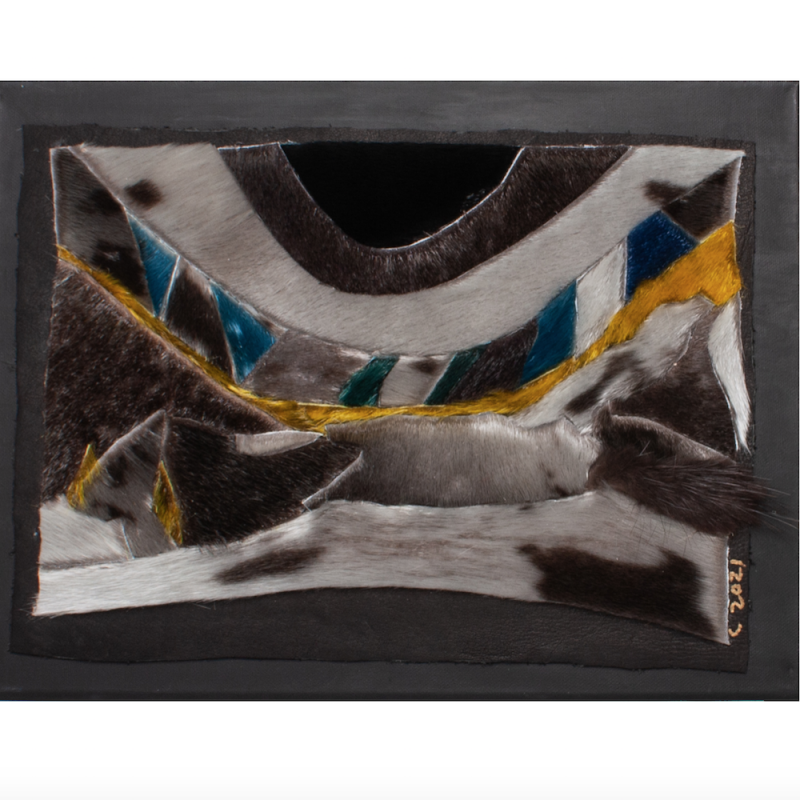News
Advancing Reconciliation Through Seal Tapestries
Through tapestries made of sealskin, designer Cheryl Fennell expresses how reconciliation is a positive thing.
When guests walked into Yellowknife’s boutique Mermaid and Moon last November, their jaws literally dropped. Amid designer Cheryl Fennell’s clothing items on display during a talk and exhibit was a series of massive tapestries, all stretched with rows upon rows of natural fur. Each of the nine pieces was different but similar in pattern. The tapestries start with a layer of black sealskin at the top, representing the sky and the great beyond.
“And then you have the layers of that black getting lighter and then ribbons of the Northern Lights,” Fennell explains. Following that is a ray of bright yellow representing the sun, while another material below it represents the physical Earth. Fennell’s use of color in her abstract works show that the North is more than just a snowy white expanse of land. It’s bright at times and ever-changing. But it also represents a much bigger theme: reconciliation.
“The tapestry is an abstract representation of the Indigenous worldview and understanding that the world is one,” Fennell says. “The natural furs are used to display the reciprocal interrelationship that exists between land, sea, animals, peoples, and the sky above. The polar (aurora lights) help show that in the darkest hour we can reconcile our differences to shine a light on our essential oneness within creation.”
What is reconciliation?
“Reconciliation gives us all an opportunity to develop relationships based on what we want to do to reconstruct society,” Fennell explains. “Some of this might mean pain and for sure will mean healing so that we can create better relationships in reconstructing the way we live and work together to build our society. That means learning from the past and finding ways to make the future more meaningful.”
Talk about reconciliation in Ottawa began in 1998 after the federal government responded to the Royal Commission on Aboriginal Peoples’ report, which spoke about residential schools. It included a commitment toward creating community-based healing, after decades of trying to assimilate Indigenous peoples through exceptionally harmful methods.
It was another decade before the federal government created the Truth and Reconciliation Commission (TRC), which documented the effects residential school had on Indigenous peoples. That same year, in 2008, former Prime Minister Stephen Harper finally issued Canada’s official apology for instating these schools. TRC released 94 calls to action in 2015 which sought to improve Indigenous people’s experiences with the child welfare system, education, language and culture, health, and justice.
Did the government follow through with its reconciliation goals?
In recent years, educational institutes across Canada have done more to include history on residential schools in the curriculum, but it’s still a work in progress. Other institutions, like the health care and justice systems, have been slower to enact meaningful change. Indigenous peoples are still over-represented in the justice system as well as in child welfare agencies. Housing and food security are still major issues in many Indigenous communities. Dozens of communities have less than optimal schools and internet connectivity, while others have been living under boil-water advisories for years.
Prime Minister Justin Trudeau announced his intentions to create a National Day for Truth and Reconciliation in 2018, but it hasn’t happened yet. Even still, critics say the act is performative, as the government continues to take Indigenous people to court over their assertion of their rights and title.
What are people doing to create reconciliation?
While there is still so much to do to affect change, more people are beginning to understand the harm colonization has caused. The University of Alberta, for example, offers a free online Indigenous studies course that is widely accessible, to help begin the conversation around reconciliation. Actor Dan Levy helped bring attention to the program when he posted about it online, encouraging others to join him in the class. In 2012, the grassroots Idle No More movement helped raise awareness on Indigenous issues and gained mainstream attention.
View this post on Instagram
Meanwhile, Indigenous peoples across Canada are able to more openly express themselves and their culture. There is more (though not enough) representation in popular media from TV shows and books to social media and fashion magazines. Indigenous citizens across Canada are thriving through traditional practices, like hunting and fishing and using traditional materials for clothing. There has also been a resurgence of traditional tattoos.
View this post on Instagram
For Fennell, she realized art is another way to express her thoughts and feelings around the subject of reconciliation. Known as a designer, Fennell wanted to try her hand at a new art form, which ultimately acted as a form of healing for her. And she was able to bring attention to a very important subject, making others think more about reconciliation. As Fennell says, “art can cause reflection that inspires a person to heal and help others heal. Our ancestors used the drum to put us in a healing state. The ti dance is all about reflection and unity. So, in art we feel that drum that beats in our heart and we get inspired to move outward.”
Art is a way to make people think or to look at things differently. She wants the world to see that reconciliation is a positive thing.
When guests first saw Fennell’s work at the November exhibit, people immediately wanted to buy it, but the tapestries were far too special to the artist. Instead, she made nine smaller versions of her pieces to sell at a showing in December. That way, the average person can look up at her art and see the beauty in thriving together.
Bibliography:
- https://www.thecanadianencyclopedia.ca/en/article/reconciliation-in-canada
- https://www.youtube.com/watch?v=LMH0IIKRcCE https://www.ictinc.ca/blog/what-reconciliation-is-and-what-it-is-not https://www.ellecanada.com/culture/society/how-these-indigenous-women-are-reclaiming-their-culture?fbclid=IwAR1el5y6qVzxYpZN2bxDlPXsmmgBS0iciW382au77EIonrAJq


 Français
Français 简体中文
简体中文 ᐃᓄᒃᑎᑐᑦ
ᐃᓄᒃᑎᑐᑦ